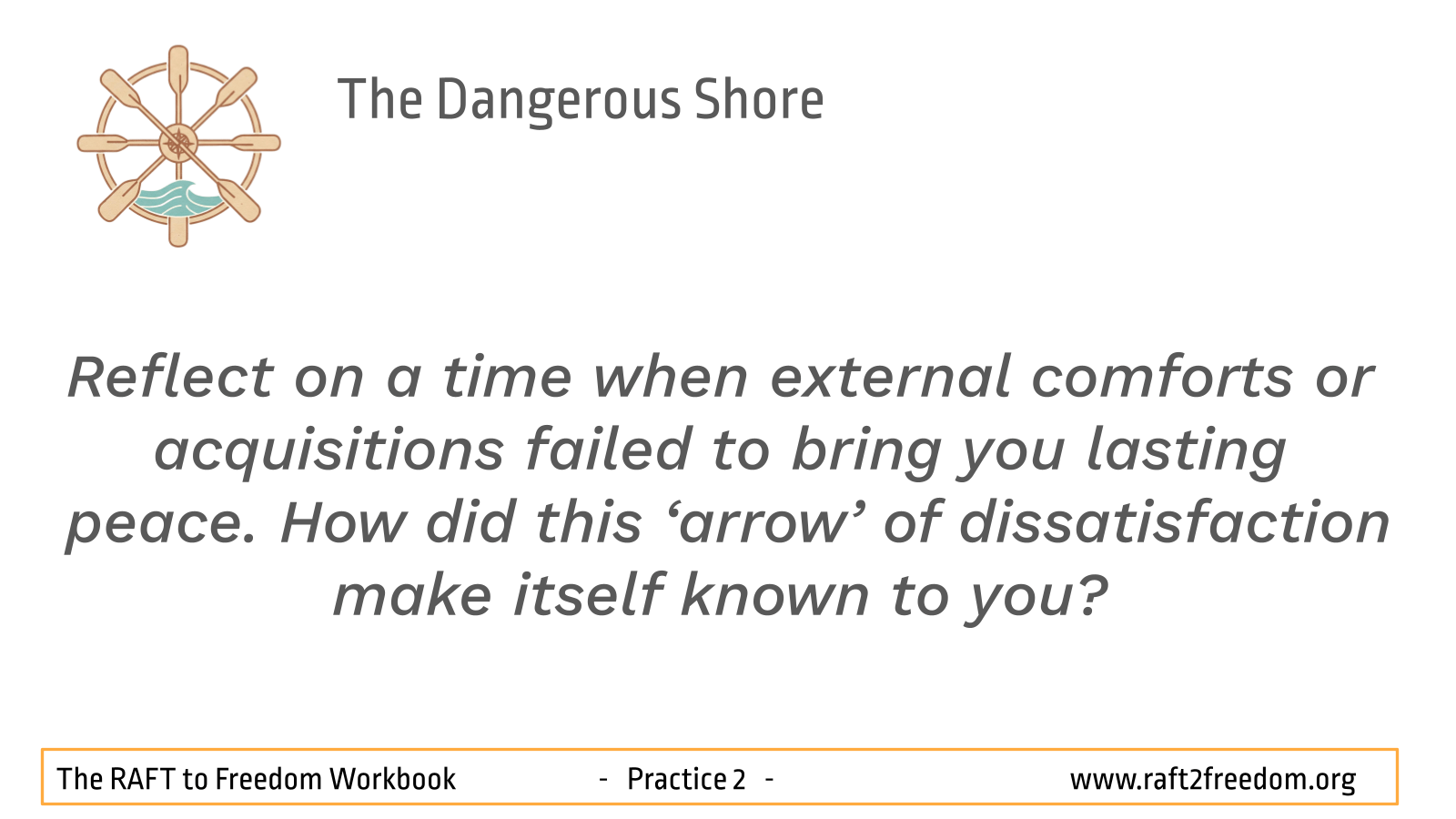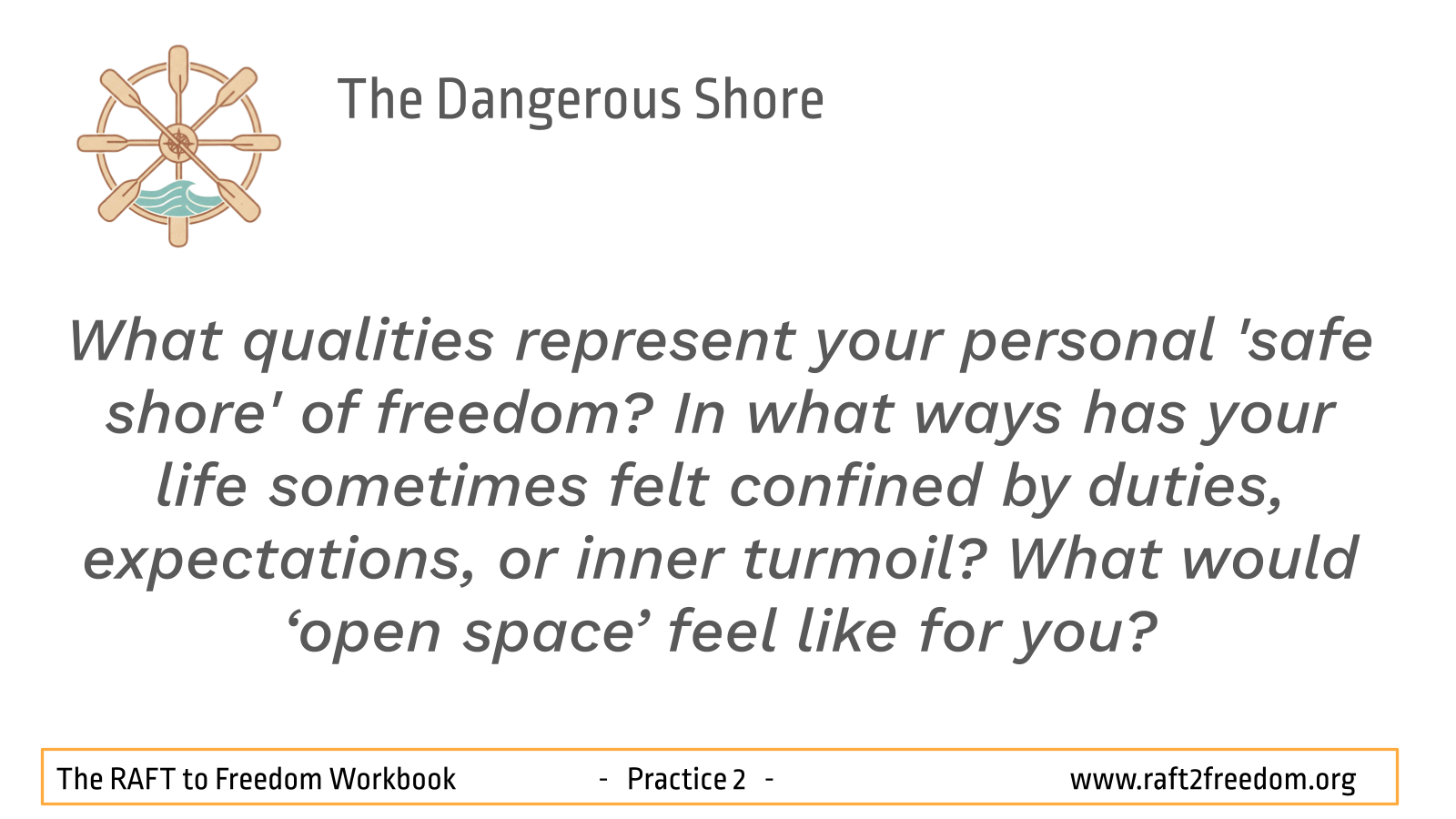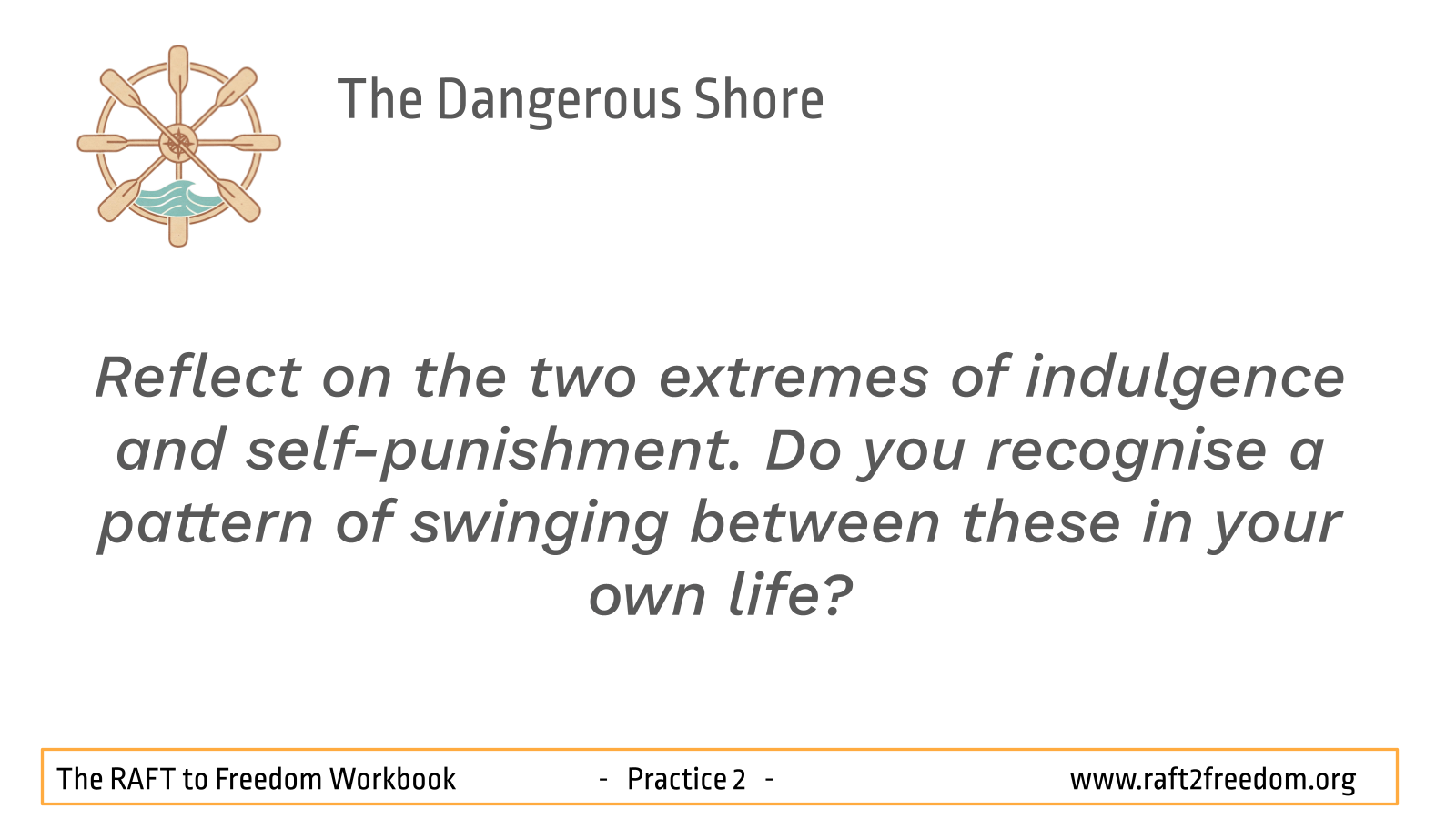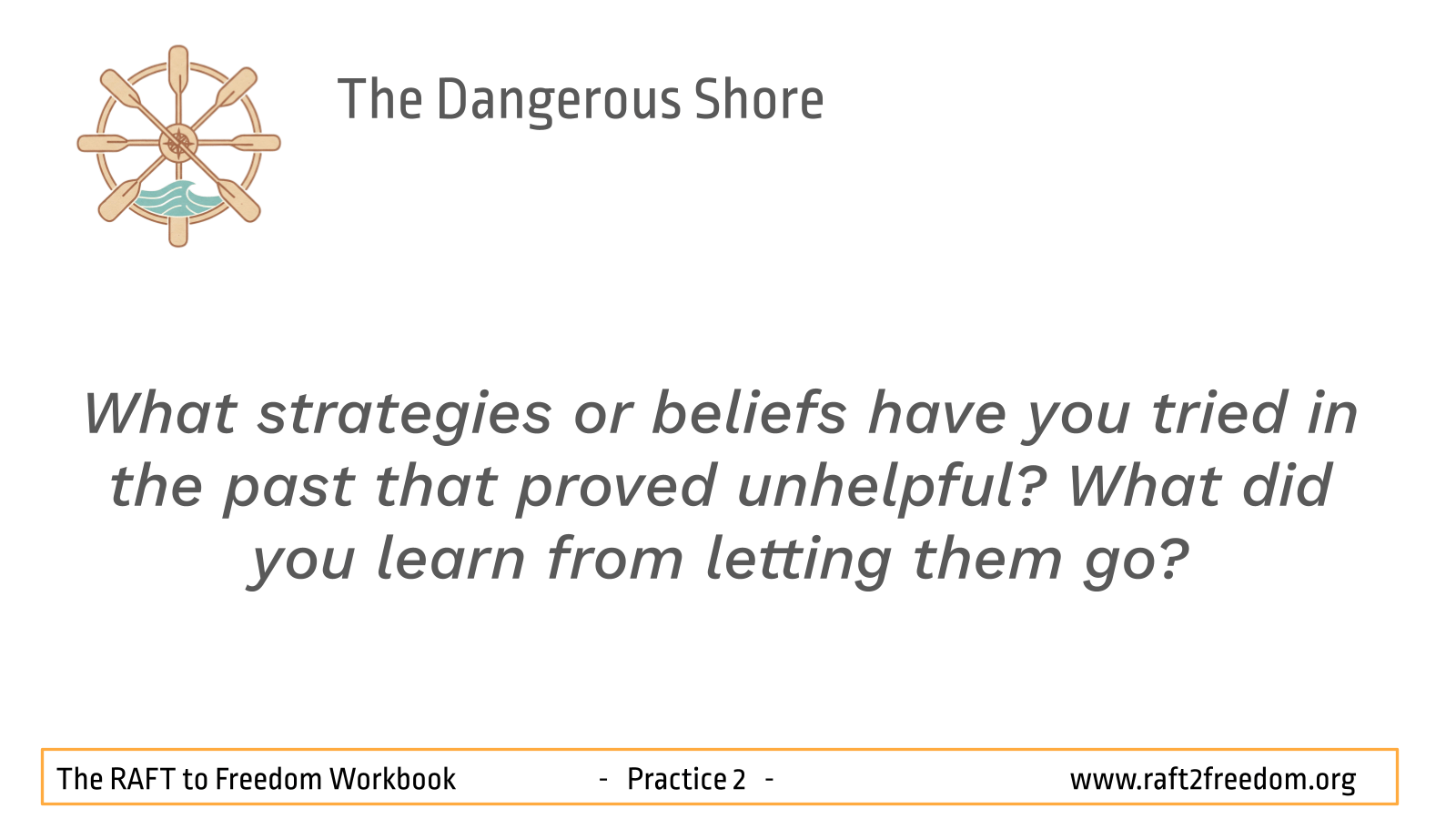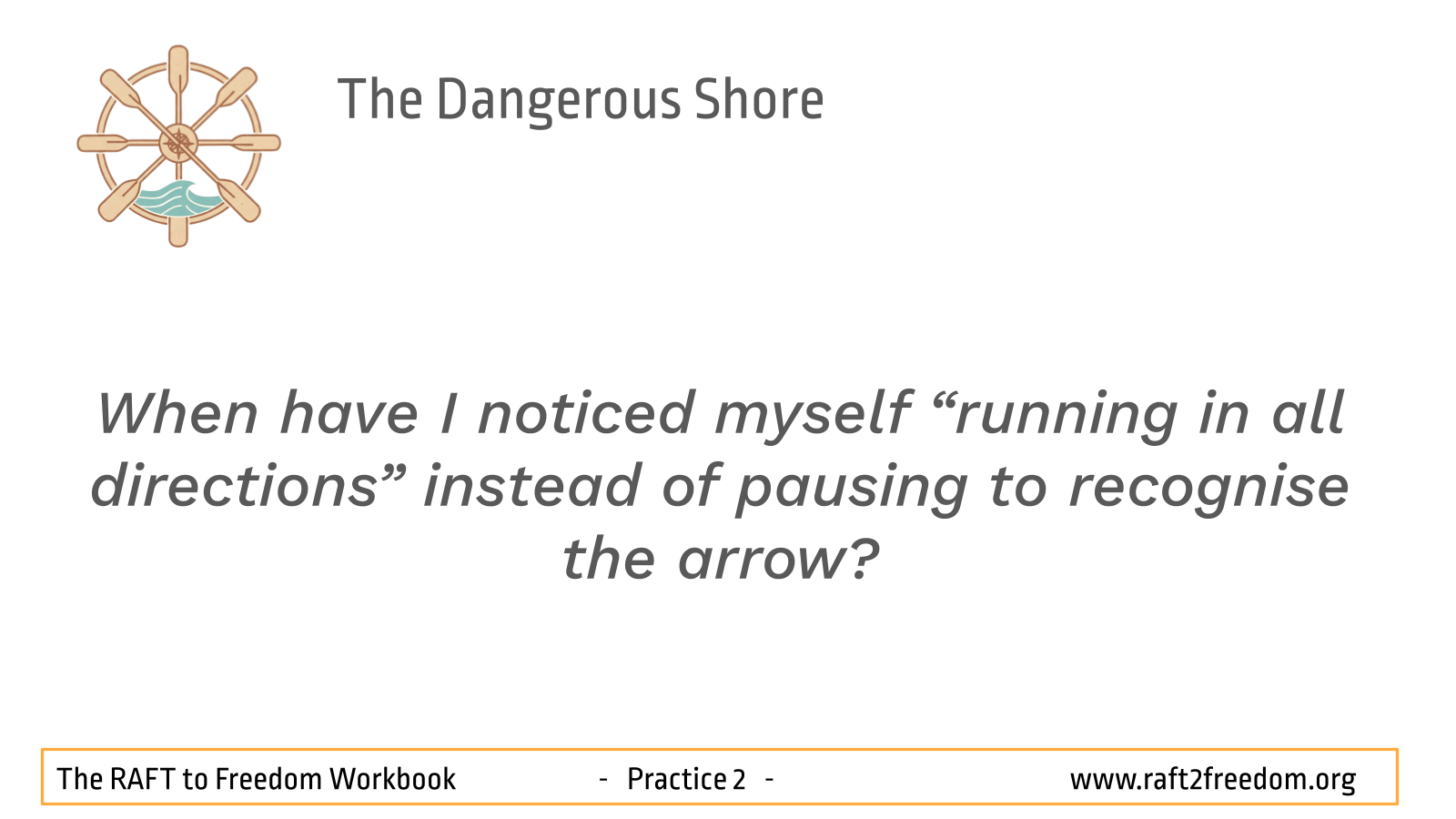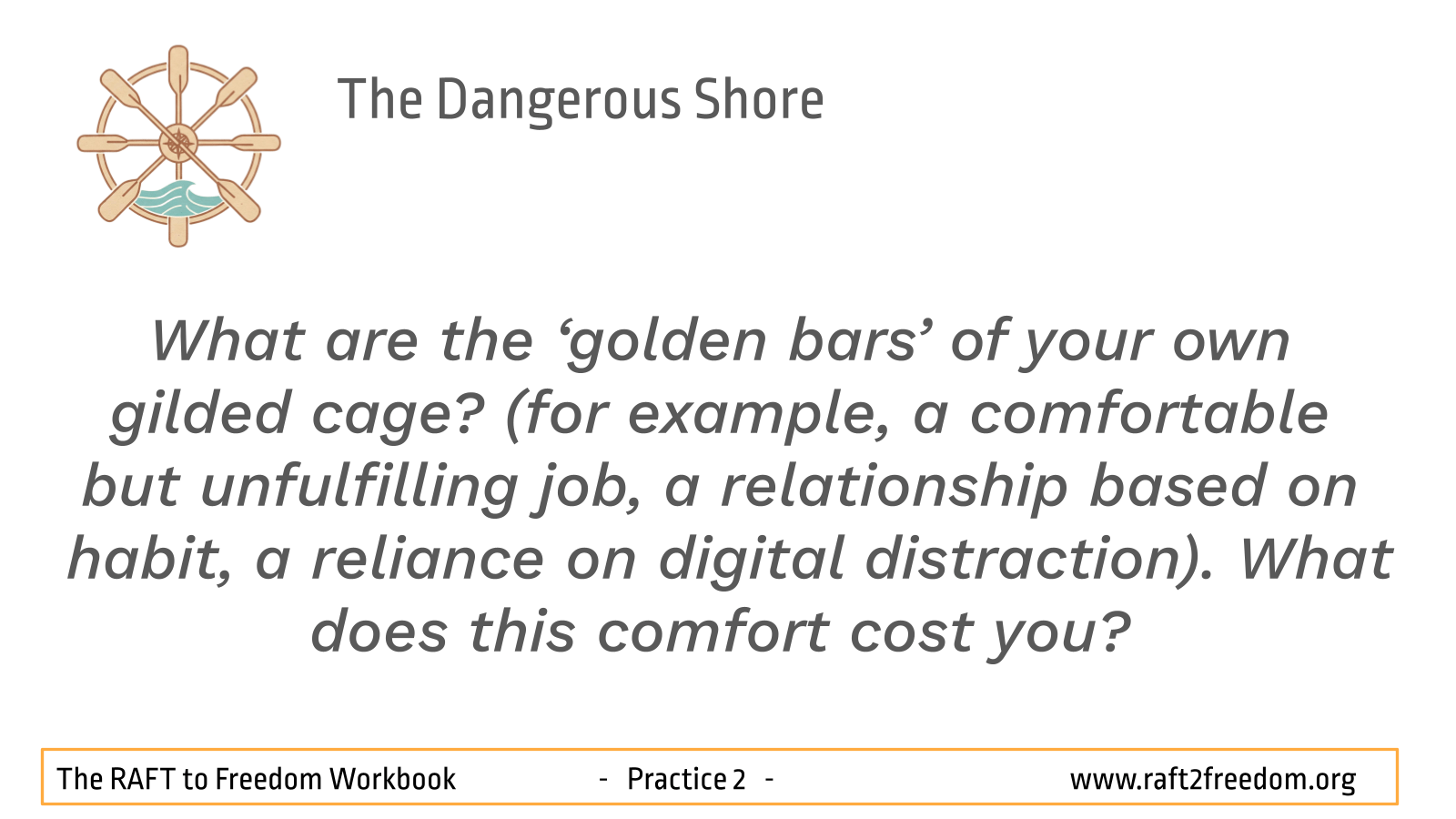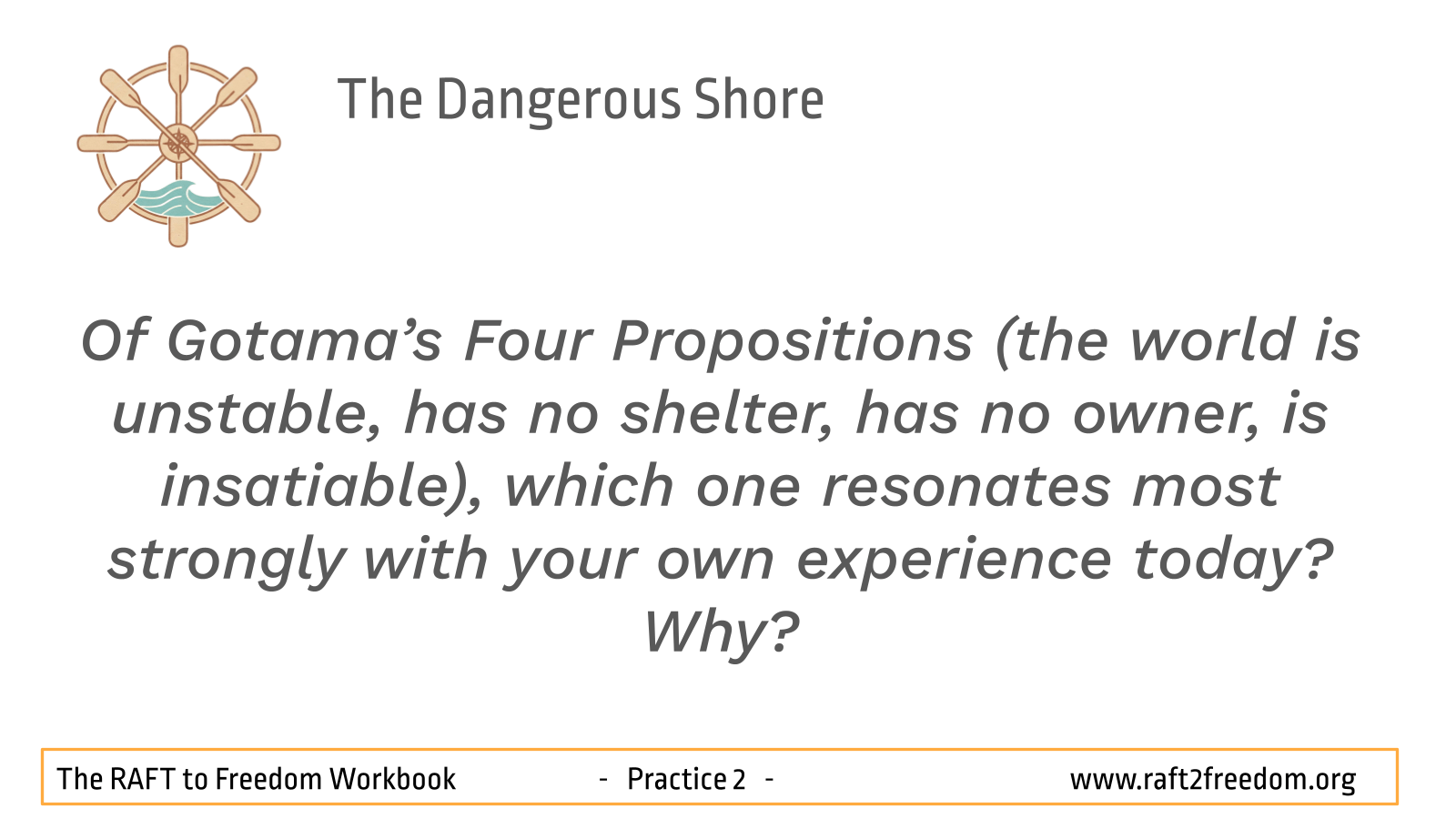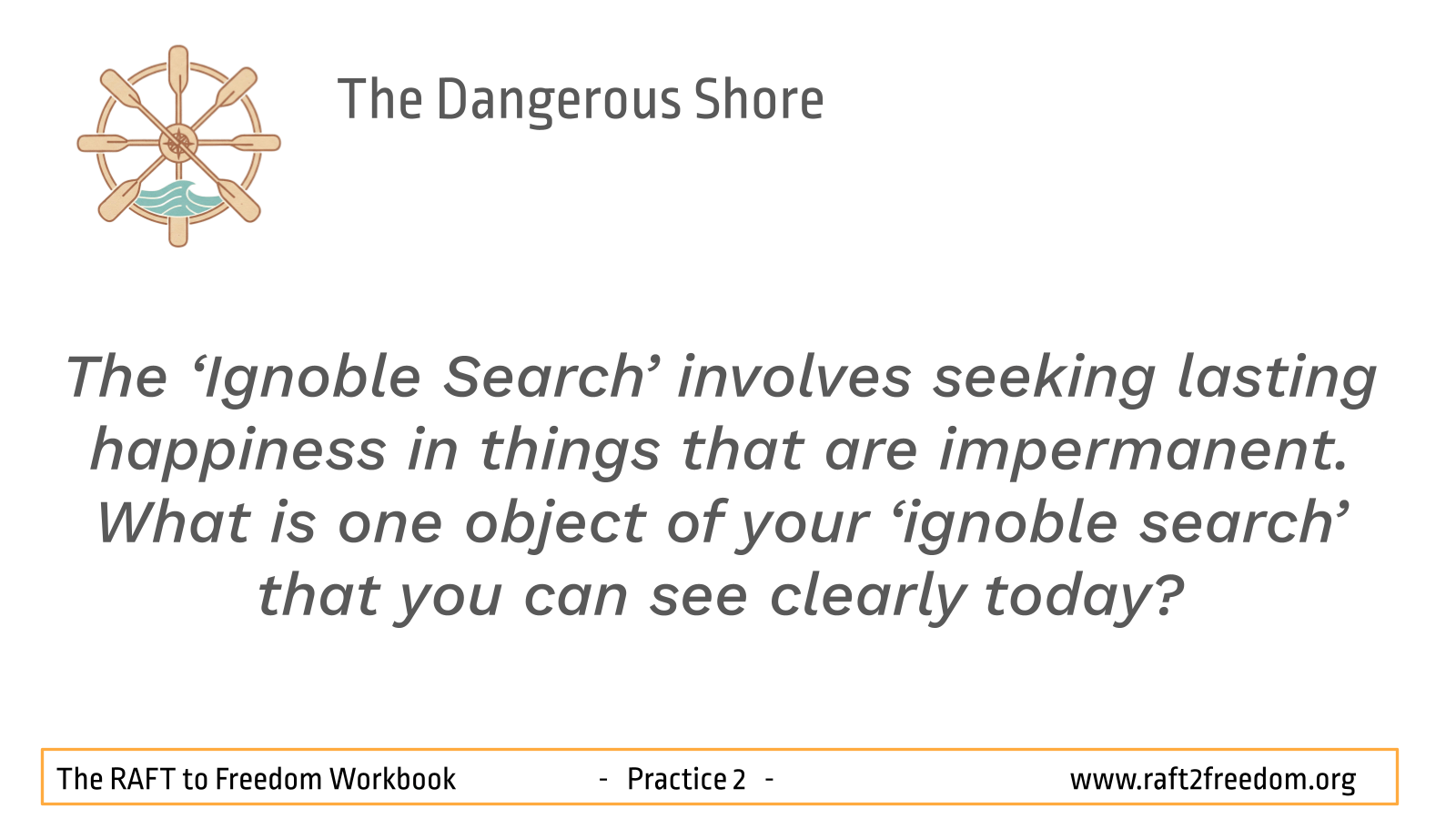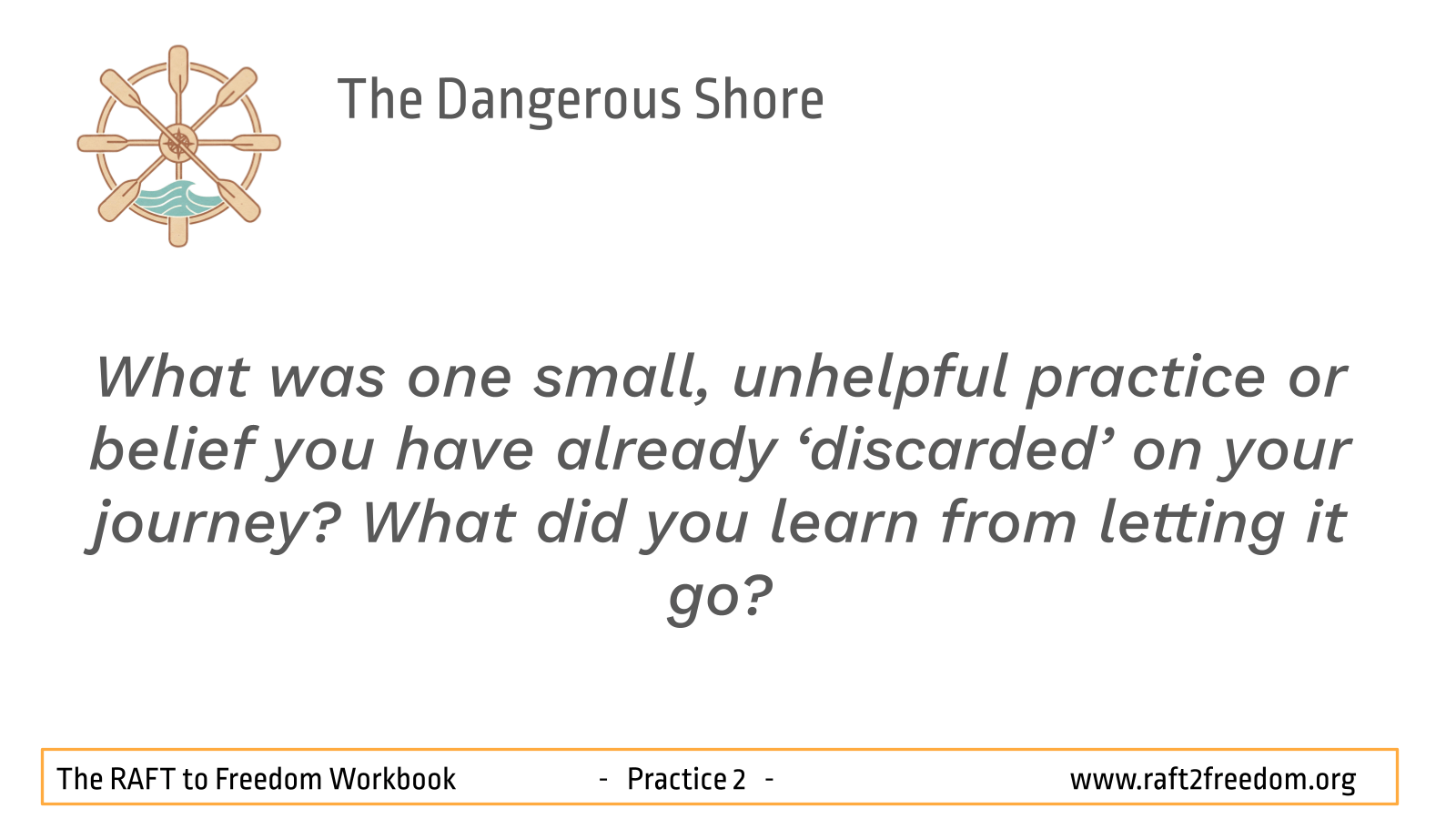Gotama’s intoxications: a troubled young man in turbulent times
Surveying the dangerous shore: Gotama’s world in his own words:
“Violence gives birth to fear.
Just look at people and their quarrels.
I will speak of my dismay
I will tell you how I experienced terror.
I saw this population flounder,
like a fish in a little puddle.
Seeing them at odds with each other,
fear came upon me.
The world around was volatile,
all directions were in turmoil.
Wanting a home for myself,
I did not see any place unoccupied.
I felt discontent
at seeing only conflict to the very end,
then I saw an arrow here, so very hard to see,
embedded in the heart.
Overcome by this arrow
you run in all directions.
But simply by pulling it out
you don’t run, you don’t sink.”

Episode 2 – Gotama’s intoxication’s
An AI generated ‘deep dive’ into this aspect of the RAFT to Freedom
Recognising the landscape of human suffering
As we begin the first stage of our journey, we find ourselves on what the ‘RAFT to Freedom’ programme calls the ‘dangerous shore’. This is the landscape of our familiar suffering, a place of turmoil and confusion where our most destructive cravings and habits hold sway. Before we can build a vessel to carry us away from this shore, we must first survey the terrain around us and understand its nature. This is the task of the ‘R’ in RAFT: to ‘Recognise’ that life is naturally painful, difficult, and disappointing.
To help us recognise the ‘dangerous shore’, we turn to the life story of Gotama (the Buddha), a historical figure who lived in India around 2,600 years ago. His journey is not a myth but a deeply human account of him confronting this same dangerous shore. By exploring Gotama’s story, we can see our own struggles reflected in his, not as personal failings, but as part of our shared human condition. His path serves as a guide, showing us the pitfalls and dead ends, but also revealing the possibility of us finding a way across the turbulent waters to the ‘safe shore’ of lasting well-being. This chapter, therefore, is not just a history lesson; it is the first step in gathering the understanding needed to construct our own raft.
The gilded cage and the three intoxications
To understand the radical nature of Gotama’s journey, we must first understand the world he chose to leave behind. Popular stories often depict him as a fairytale prince, but historical accounts suggest a more complex and relatable reality. He was born into the Sakya clan, an aristocratic republic in the Himalayan foothills. This was a turbulent era of political upheaval, and the Sakyan republic was a vassal state (a country that acknowledges the rule of a more powerful nation), living under the shadow of the powerful Kosala kingdom, Sakya was engaged in its own conflicts, including armed disputes over water rights.
While not a prince in the mythical sense, Gotama’s own accounts describe a life of extraordinary wealth and privilege. He wore only the finest perfumes and clothes:
I used no sandalwood that was not from Varanasi. My turban was from Varanasi, as were my tunic, my lower garments, and my outer cloak.
His every need was catered for:
I was delicately nurtured, most delicately nurtured, extremely delicately nurtured… I had three stilted longhouses: one for the winter, one for the summer, and one for the rainy season. I spent the four months of the rains in the rainy-season longhouse, being entertained by musicians, none of whom were male, and I did not leave that place.
Despite this gilded cage, a profound unease grew within him. He wanted to understand why he placed his happiness in sense-pleasures and in possessions that were impermanent and ultimately failed to satisfy him. Gotama recognised that his life, however comfortable, was built on a fragile foundation of denial. He later termed this denial ‘intoxication’. He saw that he, like most people, was intoxicated by three things: ‘the vitality of youth’, ‘the vigour of health’, and ‘the continuity of life itself’. These were not just states of being, but powerful delusions that created a false sense of permanence and security. To be intoxicated in this way was to revel in one’s own health while feeling repelled by the sick, to be absorbed in youth while looking down on the elderly – all while ignoring the inescapable reality that ageing, illness, and death come for everyone.
Gotama realised that, being subject to these exact same conditions, for him to continue living in a state of denial would be utterly unfitting and unfulfilling. Gotama’s deep dissatisfaction, which arose despite his unparalleled external comfort, powerfully mirrors the experience of many of us, who are caught in the tangle of habits that disconnect us from ourselves. That feeling of profound unease that persists even when life appears objectively ‘good’. The habits we use to manage our pain, difficulties and disappointments, often emerge as an attempt to escape this underlying unease, but like Gotama’s stilted long-houses, they offer us only temporary relief.
The arrow in the heart
This growing sense of existential dread is captured in the stark verses that open this chapter. Here Gotama describes seeing the world in turmoil and feeling a deep sense of fear and discontent. He then saw the source of this turmoil:
…an arrow here, so very hard to see, embedded in the heart.
Overcome by this arrow you run in all directions.
But simply by pulling it out you don’t run, you don’t sink.
This ‘arrow embedded in the heart’ is a powerful metaphor. It is described as “so very hard to see” because it represents the subtle, often unconscious, inner wound caused by our deepest afflictions – delusion, craving, and self-centered views. It is this hidden arrow that drives us to run restlessly “in all directions,” seeking satisfaction or escape but never finding peace. Pulling out the arrow means uprooting these fundamental causes of suffering. At its core, Gotama’s motivation for leaving home was to discover a cure for this condition.
This inner wound is the source of what Gotama would later formalise as his ‘First Realisation’: dukkha. Often translated as ‘suffering’, dukkha encompasses a much broader spectrum of experience, including the stress, unease, and unsatisfactoriness inherent in our conditioned existence. It points to the fundamental truth that even pleasant experiences are impermanent and therefore cannot provide lasting, secure happiness. This insight finds a strong parallel in the modern psychological concept of the ‘hedonic treadmill,’ which observes that humans tend to quickly return to a baseline level of happiness, regardless of major positive or negative life events. The satisfaction from any new achievement or possession never lasts, leading to a perpetual cycle of seeking more.
This is the ‘First Realisation’ that we must ‘Recognise’ (R). The arrow of ‘suffering’ is a universal part of the human condition that is explored in more detail in Chapter 5. The compulsive patterns we get caught in are often just our frantic attempts to run from discomfort. The first stage of our journey requires us to stop running and, with self-compassion, acknowledge that the arrow is there. This honest and necessary surrender is grounded in Gotama’s ‘First Realisation’, that life is naturally painful, difficult and disappointing.
The turning point: embarking on the noble search
It seems likely that Gotama found this profound realisation overwhelming. We can perhaps read between the lines of these verses and other reflections by Gotama, that he was a troubled and anxious young man living in turbulent times. Gotama would have been conflicted by the weight of family and societal expectations. His experience prompted him to ‘go against the stream’, and he later captured his motivation with a powerful metaphor:
This home life is confinement, a basis for dust;
the going forth is like an open space
For him, the ‘home life’ was not a sanctuary but a ‘confinement,’ a cramped space filled with obligations that restricted his ability to seek a deeper truth. It was a “basis for dust,” a realm where the ‘dust of passion’ (craving, conflict, and confusion), was constantly stirred up, clouding the mind. He saw that leaving these worries behind was the only way to find the ‘open space’ – the mental and spiritual clarity needed to find a real end to fear and suffering.
…there are two kinds of illness. What two? Mental and physical. Some sentient beings are seen who can claim to be free of physical illness for a year, or two, or three years … even up to a hundred years or more. But it’s very hard to find any sentient beings in the world who can claim to be free of mental illness even for a moment, apart from those who have overcome intoxicating inclinations…
Gotama
Gotama’s ‘Four Propositions’: raw insights for change
In Gotama’s earliest teachings, he presented the well known clinical framework of the Four Realisations (Four Noble Truths). But in later teachings, he also presented the lesser known but perhaps just as important ‘Four Propositions’ expounding the way things really are. These propositions are raw and piercing insights into Gotama’s existential crisis. After hearing them, a young wealthy nobleman called Raṭṭhapāla, was so inspired that he immediately sought to be ordained – to leave his family and own lavish lifestyle behind and to follow Gotama into homelessness.
These propositions were not abstract philosophies, but lived recognitions of fragility, dread, and powerlessness – the very tremors that often stir a person toward change. The Four propositions unveil the collapse of false security: the crumbling walls of the gilded cage, the failure of intoxicants to numb reality, and the painful, clear sight of the arrow embedded in the heart. These propositions became part of the catalyst for his journey.
- All beings are swept along toward old age and death: The world is unstable.
- Life is insecure, and nothing is truly within our control: The world has no shelter and no saviour.
- We possess nothing – everything must be relinquished at death: The world has no owner.
- There is a lack at the core of every life. No one is fully satisfied, for beings are enslaved by craving: The world is insatiable.
Driven by this sense of spiritual urgency, Gotama made a radical decision. He resolved to leave his life of privilege in search of peace, to find an end to the inner and outer conflict that caused so much fear. He sought a definitive end to suffering, leaving behind his wife Yaśodharā and newborn son Rāhula. This was not an act of abandonment but a courageous commitment to embark on what he termed the ‘Noble Search’ as distinguished from the ‘Ignoble search’ pursued by most.
- The ‘Ignoble search’: Is the quest for happiness in things that are themselves subject to change, decay, and loss. Gotama saw this in his own life, recognising that his attachments to acquisitions – including spouses and children, male and female slaves, goats and sheep, fowl and pigs, elephants, cattle, horses, and even gold and silver – were impermanent and could not provide true security.
- The Noble Search: Conversely, is the quest for that which lies beyond these conditions – a lasting freedom from the entire cycle of suffering. Something “wide and pure” – a life free from the agitation of ignorance and craving. Gotama describes leaving home as a quest for ‘true happiness’, grounded on calm and peace.
This distinction provides a powerful lens for our own journey. The cycle of our harmful compulsions is an intense manifestation of the ignoble search – our repeated attempt to find relief in substances or behaviours that are impermanent and ultimately lead to more pain. The decision to begin building our raft marks a pivotal turning point. It is our commitment to undertake our own ‘Noble Search’ – to turn away from seeking temporary fixes and begin the journey toward genuine, lasting freedom.
Gathering materials: the search for a seaworthy raft
Gotama’s search was a rigorous, six-year process of gathering materials for his own raft, a methodical investigation in which he tested various teachings and practices, keeping what was useful and discarding what was not.
Immediately after leaving home, he sought out the most esteemed meditation teachers of his time. He mastered their advanced techniques, attaining profound states of mental concentration. Yet, he recognised that these states, however blissful, were still temporary. They were useful tools, but they were not the final answer; they could not, by themselves, construct a raft that would reach the far shore of complete freedom.
Having found these teachings insufficient, he dedicated himself to the opposite extreme of his former life: the path of severe self-mortification. The accounts of this period are harrowing; he engaged in extreme fasting, painful postures, and severe neglect of his body, pushing himself to the brink of death.
Self-harm is not the way
After these gruelling years, he came to a critical realisation: these practices had brought him no closer to his goal. They had only weakened his body and exhausted his mind, making the clarity required for wisdom impossible. He had tested these materials – harsh self-punishment and extreme denial – and found them rotten. They were unsuitable for building a durable vessel. This path, too, was a dead end. This episode holds a vital lesson: healing cannot be achieved through self-punishment. The cycle of indulgence followed by shame and harsh self-criticism is just another barren extreme.
It was then that a memory arose of him sitting in the cool shade of a tree as a boy, where he had spontaneously entered a state of deep, pleasant calm. He realised that there was a form of wholesome pleasure, born of clarity and peace, that could support his path. This insight marked his discovery of the ‘Middle Way’. Gotama abandoned his harsh austerities, accepted nourishing food, and regained his strength.
Avoiding extremes and the ‘Middle Way’
In his first teaching, Gotama laid out this core principle of the ‘Middle Way’, declaring that two extremes should be avoided: addiction to sensual indulgence and addiction to self-harm. The Middle Way, he explained, is the balanced path between them – precisely as the ‘Noble Eightfold Path’, explored in detail in Chapter 57. This discovery of the ‘Middle Way’ provides the central principle for the RAFT to Freedom. It is a balanced, sustainable framework that steers clear of both destructive indulgence and self-punishing rigidity. It reframes our journey not as a grim battle, but as the skilful and compassionate cultivation of the inner resources needed to build our vessel and navigate to the safe shore.
Māra the saboteur
Throughout this arduous search, Gotama was not only contending with physical hardships but also with the powerful internal forces of temptation, doubt, and fear. In the Buddhist tradition, these forces are personified as Māra, a figure representing the embodiment of harmful cravings and delusion. Māra is not an external demon but a metaphor for the persuasive whispers in the mind that try to pull us off course with doubt, rationalisations, and the lure of old destructive habits. Gotama’s path required him to constantly see through these deceptions, a skill of clear recognition as explored in much greater detail in Chapter 14.
The GOTAMA Practice
This chapter is about ‘Recognising’ the terrain of our suffering. The following practices use Gotama’s name as a guide to walk in his footsteps, not to fix anything, but to see our own experience more clearly. Approach them as gentle experiments in awareness.
- G – Ground yourself: Ground in the felt sense. Gotama’s journey began not with a theory, but with the felt reality of unease. When a moment of irritation or craving arises, pause. Instead of running, Ground your awareness in the body. Where is this ‘arrow’ felt? Is it a tightness in the chest? A hollowness in the stomach? A buzzing in the head? Simply place a hand there, acknowledging the raw sensation with presence instead of fear. Instead of pushing the pain away, name the difficulty and invite self-compassion: “This is hard. Let kindness be here.”
- O – Observe ‘the intoxications’: Gotama saw through the delusions of youth, health, and life. We can observe our own. This week, when a strong judgement about someone older arises, gently note, ‘intoxicated with youth’. When frustration with a physical limitation appears, whisper, ‘intoxicated with health’. And when resistance to the thought of our impermanence arises, acknowledge, “intoxicated with life.” This isn’t about self-criticism; it’s about seeing the subtle assumptions that fuel our reactivity.
- T – Taste open space: The motivation for the Noble Search was the contrast between the ‘dusty confinement’ of his life and the possibility of ‘open space’. This week, intentionally taste small pockets of this. It could be five minutes of silence with a cup of tea and no phone. It could be a walk where you just notice the sky. These moments are rehearsals for freedom, reminding your nervous system that a life beyond the dusty room is possible.
- A – Acknowledge the raw truth: Gotama’s Four Propositions are a stark acceptance of reality. Choose one for the day: ‘The world is unstable,’ ‘The world has no shelter and no saviour,’ ‘The world has no owner,’ or ‘The world is insatiable.’ Hold it lightly in mind and acknowledge how its truth shows up in small ways – a plan changing, a moment of insecurity, the desire for more. This is not pessimism; it is the practice of aligning with reality.
- M – Map your confinement: Gotama felt his life was a ‘cramped, dusty room’. Take a moment to map your own life. What obligations, relationships, or thought patterns feel like confining walls? What is the ‘dust of passion’ in your life – the gossip, the endless scrolling, the comparing – that clouds your mind? The first step is not to break down the walls, but simply to recognise them for what they are.
- A – Awaken the Noble Search: Recognising the confinement and the arrow is not the end; it is the beginning. The final step is to awaken the aspiration (Noble Desire, Chapter 21) for your own ‘Noble Search’. Form a clear resolve: “Seeing the dis-ease of the ignoble search, I resolve to seek genuine well-being.” This sets your compass, turning recognition into a purposeful journey. This action is a ‘stroke of the oar’ on your raft.
Self-reflections
Take a few moments for honest self-inquiry, approaching these questions with a caring and curious mind:
- Reflect on a time when external comforts or acquisitions failed to bring you lasting peace. How did this ‘arrow’ of dissatisfaction make itself known to you?
- In what ways has your life sometimes felt confined by duties, expectations, or inner turmoil? What would ‘open space’ feel like for you?
- Reflect on the two extremes of indulgence and self-punishment. Do you recognise a pattern of swinging between these in your own life?
- What strategies or beliefs have you tried in the past that proved unhelpful? What did you learn from letting them go?
- When have I noticed myself “running in all directions” instead of pausing to recognise the arrow?
- What are the ‘golden bars’ of your own gilded cage? (for example, a comfortable but unfulfilling job, a relationship based on habit, a reliance on digital distraction). What does this comfort cost you?
- Of Gotama’s Four Propositions (the world is unstable, has no shelter, has no owner, is insatiable), which one resonates most strongly with your own experience today? Why?
- The ‘Ignoble Search’ involves seeking lasting happiness in things that are impermanent. What is one object of your ‘ignoble search’ that you can see clearly today?
- What was one small, unhelpful practice or belief you have already ‘discarded’ on your journey? What did you learn from letting it go?
Journaling prompts
Use your journal to explore these themes further:
- The gilded cage: Write about a time you were in a ‘gilded cage’ – a situation that looked good on the outside but felt empty or unsatisfying on the inside. What did this teach you about where lasting happiness can (and cannot) be found?
- Confinement and open space: Reflect on Gotama’s feeling of being confined by a ‘dusty’ home life. What aspects of your life feel confining or ‘dusty’ with passion and conflict? What would it mean for you to step into ‘an open space’ of greater clarity and freedom?
- Committing to the journey: The ‘Noble Search’ begins with a powerful resolve. Write down your own intention for this journey. What kind of peace are you searching for? What commitment are you making to yourself as you begin to build your raft?
- Materials for your raft: Gotama’s story shows him gathering and discarding materials for his journey. What ‘materials’ from his experience – such as courage, clear-seeing, self-compassion, or the willingness to discard what doesn’t work – feel most essential for you to gather for your own raft right now?
- An act of self-compassion: Gotama realised that punishing his body was a dead end. Write about one way you can abandon self-punishment this week and offer yourself an act of nourishment or care instead.
- A weather report from the ‘Dangerous Shore’: Write a short ‘weather report’ from your dangerous shore today. What are the prevailing winds (habitual thoughts)? What are the hidden reefs (triggers)? What storms (emotional reactions) have passed through recently?
- Dialogue in the gilded cage: Write a short dialogue between the part of you that wants to stay safe and comfortable in the gilded cage and the part that yearns for the ‘open space’ of the Noble Search. Let both voices speak honestly without judgment.
- An act of nourishment: Gotama chose nourishment over self-harm to find the Middle Way. Identify one way you typically engage in self-punishment (e.g., harsh self-talk, skipping a meal, depriving yourself of rest). Plan and write down one specific, compassionate act of nourishment you will offer yourself instead this week.
- The ‘Four Propositions’ in your life: Choose one of the Four Propositions (unstable, no shelter, no owner, insatiable). Write about a specific time in your life when you experienced the truth of this proposition directly. How did it feel? What did it teach you?
- A new map: How does viewing your journey through the lens of Gotama’s story—as a universal human quest rather than a personal failure—change your perspective on your own struggles?
- Shelter and ownership: Reflect on something you thought would provide security or permanence. How has it changed or slipped away? What did this teach you?
- The insatiable world: Journal about a desire or pattern that never truly satisfied you. How does seeing it as “insatiable” shift your relationship with it?
- Daily GOTAMA check-in: At the end of the day, revisit the acronym. Which step (Ground, Observe, Taste, Acknowledge, Map, Awaken) felt most alive? Which do I need to strengthen tomorrow?
Supporting material: scientific and philosophical perspectives
For those interested in the scientific and philosophical underpinnings of abandoning harmful cravings and compulsions, the following overview highlights some key connections. The path Gotama discovered resonates remarkably with contemporary scientific and philosophical understanding of the human mind.
- Neuroscience: Gotama’s insight into craving (taṇhā) is illuminated by modern neuroscience. The habits we use to manage pain often hijack the brain’s natural reward system. Substances and compulsive behaviours can flood this system with dopamine, creating intense but temporary pleasure. The brain adapts by reducing its own sensitivity, meaning natural rewards become less satisfying and more of the substance or behaviour is needed to get the same effect, creating a painful cycle. The Middle Way’s emphasis on mindfulness and mental training aligns with the principle of neuroplasticity – the brain’s ability to change and form new neural pathways. Practices like meditation can strengthen the prefrontal cortex, the area responsible for impulse control and wise decision-making, effectively ‘rewiring’ the brain away from automatic, compulsive loops and towards conscious, healthy choices.
- Psychology: The ‘First Realisation’ of pain, difficulties and disappointments, finds a strong parallel in the psychological concept of the ‘hedonic treadmill’. This theory suggests that people tend to return to a relatively stable baseline of happiness, regardless of positive or negative life events. This explains why the ‘Ignoble search’ for lasting happiness in fleeting pleasures is ultimately frustrating. Furthermore, some of the most effective modern therapies, such as Acceptance and Commitment Therapy (ACT) and Dialectical Behaviour Therapy (DBT), integrate core principles from Gotama’s path, such as mindfulness, acceptance of difficult feelings, and committed action based on personal values.
The curious paradox is that when I accept myself just as I am, then I can change.
Carl Rogers
- Philosophy: Gotama’s ‘Noble Search’ resonates deeply with themes in existential philosophy, which grapples with universal human concerns about suffering, freedom, death, and the search for a meaningful life. Both traditions recognise that confronting the difficult realities of the human condition, rather than avoiding them, is the necessary catalyst for growth and transformation. Gotama’s journey is a profound example of taking responsibility for one’s own path to find an authentic and purposeful way of living.
Closing remarks
The story of Gotama’s unhappiness is, in many ways, our own story. It teaches us that the deep dis-ease we feel is not a sign that we are uniquely broken, but a fundamental part of the human condition that can be a powerful catalyst for change. His feeling of being trapped in a ‘confinement’ of worldly duties and expectations, in a house ‘dusted’ with passion and conflict, is a timeless expression of feeling overwhelmed by life. His journey was a methodical process of gathering materials for his raft. He tested advanced meditation and found it useful but incomplete. He tested extreme self-punishment and discarded it as harmful. He learned from every step.
His discovery of the ‘Middle Way’ provides the blueprint for our ‘RAFT to Freedom’. It is a path of radical balance, wisdom, and compassion. By ‘Recognising’ the landscape of our suffering with the same clear-eyed courage he demonstrated, we take the first essential step. We stop running from the arrow in our heart and instead turn to face it, ready to learn the skills needed to gently remove it and navigate our way to the safe shore.
It took Gotama six years to gather the materials for his raft and journey to the ‘Far Shore’ – a marathon not a sprint. This was followed by 45 years of practice until his final dying breath. Some of the skills he tried were not beneficial nor suitable, so he discarded them; he jettisoned them and left them behind.
In ‘Recognising’ the arrow in the heart – our own and others’ – Gotama encouraged us to respond with compassion (see Chapter 6). This recognition is not self-blame but a tender awareness of shared human pain.
Remember to remember
Gotama was an ordinary man who had some extraordinary insights. His initial journey, his metaphorical raft, from suffering to freedom took six years. After he woke up to how life really is, he continued to practice for the rest of his life. He was still subject to pain but he chose not to suffer for it.
He left home at the age of 29, “while still a black-haired young man endowed with the blessings of youth in the first stage of life.” He died 51 years later in pain but at peace with himself and the world, as an ‘old homeless beggar’.
“Just as one would use a raft to cross the turbulent waters and reach the safety of the far shore, so too my teachings are like a raft, intended for crossing and not for holding onto.” ~ Gotama
Gotama finally arrived at the ultimate destination. His teachings never promised rainbows and unicorns but he did promise the possibility of individual peace, freedom and a perfect unshakable liberated heart. His last words to his followers can be paraphrased as:
Everything falls apart. Be careful and you will succeed.
Sutta References
- Pabbajjā Sutta (Snp 3.1 – The Going Forth)
- Summary: This early discourse recounts Gotama’s departure from his home life. It contains his powerful reflection on the household life as a “confinement” and a “basis for dust,” contrasting it with the freedom of the “open space” of renunciation. This sutta provides a direct insight into the psychological motivations that propelled his search for an end to suffering.
- Sukhumāla Sutta (AN 3.39 – Refinement)
- Summary: In this discourse, Gotama describes his incredibly luxurious and sheltered upbringing. He reflects on the inevitability of ageing, sickness, and death, and how seeing these realities led him to abandon the “intoxications” of youth, health, and life. This sutta is crucial as it shows that profound dissatisfaction can arise even amidst privilege and is rooted in seeing the true nature of existence.
- Ariyapariyesana Sutta (MN 26 – The Noble Search)
- Summary: This is a key biographical discourse where Gotama recounts his own spiritual journey. He defines the “ignoble search” for happiness in conditioned things (which are subject to decay and loss, such as family, servants, and wealth) and contrasts it with the “Noble Search” for the unconditioned, a lasting freedom from suffering (Nibbāna). This provides the core framework for understanding the shift in intention required for our own journey.
- Dhammacakkappavattana Sutta (SN 56.11 – Setting the Wheel of Dhamma in Motion)
- Summary: Considered Gotama’s first sermon, this discourse lays out the foundational teaching of the Middle Way, which avoids the two extremes of sensual indulgence and self-mortification. It introduces the Four Noble Truths (the Four Realities) and the Noble Eightfold Path, providing the essential map for the entire journey to freedom.
- Raṭṭhapāla Sutta (Majjhima Nikāya 82) – Of Renouncing The World
- Summary: This discourse contains the “Four Summaries of the Teaching,” which articulate a raw, pre-doctrinal understanding of the world’s instability, lack of shelter, impermanence of ownership, and insatiable nature. They represent a powerful expression of the initial existential crisis.
RAFT to Freedom © 2025 by Dr Cathryn Jacob and Vince Cullen is licensed under CC BY-NC-SA 4.0. To view a copy of this license, visit https://creativecommons.org/licenses/by-nc-sa/4.0/ |

